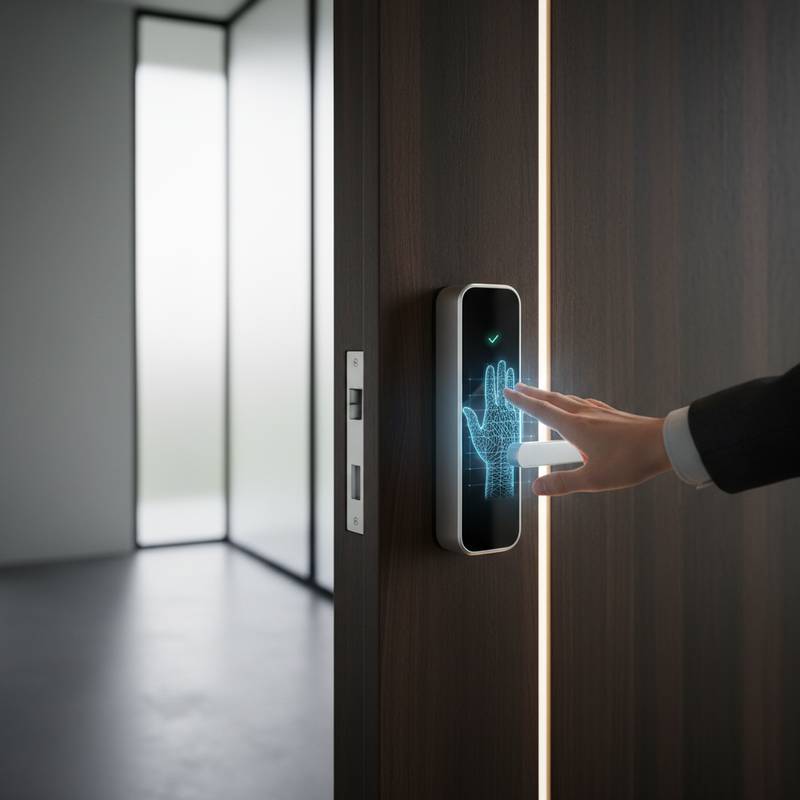Imagine Approaching Your Door Hands-Free
You return home carrying groceries, balancing a coffee cup, and searching for your phone in a crowded bag. Fumbling for keys or entering a passcode adds unnecessary frustration. With palm recognition smart locks, you position your hand near the device, and it identifies you in seconds to grant access. This biometric solution merges convenience, robust security, and innovative design for everyday use.
Challenges of Traditional Entry Methods
Conventional locks rely on physical keys or memorized codes, both prone to loss, duplication, or oversight. Keys demand constant carrying, while codes risk unauthorized sharing or forgetfulness. Fingerprint systems, though advanced, falter in moist environments or with dirty hands. Families, property managers, or multi-user households face added complexity in access control.
Palm recognition addresses these issues by providing an intuitive, dependable alternative suited to contemporary smart homes.
Understanding Palm Recognition Technology
Palm recognition employs infrared sensors and sophisticated algorithms to capture the distinct vein structures under the skin. This internal mapping resists replication more effectively than surface-based methods like fingerprints or facial recognition. The system analyzes palm shape alongside vascular layout for comprehensive authentication.
Enrollment involves scanning your palm to create an encrypted template stored locally on the device, without retaining images. Subsequent verifications match real-time scans against this secure data, delivering rapid results grounded in precise engineering.
Performance Insight
Beyond ease of use, palm recognition excels in dim environments. Infrared technology operates independently of external light, ensuring functionality during nighttime or brief power interruptions, provided the lock maintains battery or reserve power.
Selecting the Right Palm Recognition Smart Lock
Biometric lock options proliferate in the market. To upgrade your entryway effectively, evaluate models based on features, integration, and cost.
1. Entry-Level Selection: Lockly Flex Touch ($149)
This deadbolt incorporates fingerprint scanning and mobile app controls at a budget-friendly price. Although it lacks dedicated palm recognition, it serves as an accessible introduction to biometrics for compact residences or rentals.
2. Balanced Option: Arpha Smart Palm Lock ($279)
Tailored for palm vein detection, this unit features dual infrared sensors for detailed surface and subsurface analysis. It connects via Wi-Fi, responds to voice commands from Alexa or Google Assistant, and generates short-term codes for visitors.
3. High-End Choice: Schlage Encode Plus Bio-Palm ($499)
Combining palm verification with Apple Home Key, this lock enables access via hand or smartphone. Matter protocol ensures seamless operation across diverse smart home platforms, avoiding vendor limitations. Its durable construction and advanced encryption suit security-conscious users seeking simplicity.
Installation and System Integration
Most palm recognition locks fit standard deadbolts with basic tools, though sensor alignment demands care for optimal performance. Professional installation, costing $75 to $150, proves valuable for those unfamiliar with wiring or drilling.
Key factors to assess include:
- Smart Home Integration: Compatibility with Matter, Alexa, Google Home, or Apple HomeKit.
- Power Options: Reliance on AA batteries, supplemented by USB-C for emergencies.
- Connection Types: Wi-Fi for remote monitoring versus Bluetooth for on-site use.
Property owners benefit from remote tools, such as issuing digital passes, to streamline guest management.
Enhancing Security and Protecting Privacy
Palm recognition prioritizes safety through its subsurface data, impervious to visual copying or photography. Encrypted storage confines information to the device, with cloud transmission optional via app settings.
To bolster protection:
- Select devices with AES-256 encryption standards.
- Update firmware routinely through the manufacturer's application.
- Enable two-factor verification for any remote functions.
Advanced Security Feature
Certain models incorporate liveness detection, which confirms vitality by measuring blood flow and warmth. This safeguard blocks attempts using static replicas or fabricated materials.
Budgeting and Upkeep for Longevity
Quality palm recognition locks range from $250 to $500. Battery life typically exceeds one year with moderate activity. Maintain a manual override key and alternative power ready for rare failures; many units feature concealed USB-C ports for interim charging.
Routine care involves gentle wiping of the sensor with a microfiber cloth. Steer clear of harsh chemicals to preserve the infrared lens integrity.
Implementing Palm Recognition in Your Home
Adopting palm recognition transcends gadgetry; it streamlines routines and fortifies defenses. Begin with a single door upgrade matching your finances and existing setup, then scale to additional areas as familiarity builds.
For expert assistance, connect with vetted installers through reliable platforms. They often complete hardware and configuration tasks in less than an hour.
The true value emerges in seamless interactions: approach, present your palm, enter without delay. This approach elevates home access to a more efficient, intelligent level.
Frequently Asked Questions
How does palm recognition differ from fingerprint technology?
Palm systems chart internal veins, whereas fingerprints capture external patterns. Vein-based verification resists forgery and performs reliably across environmental challenges.
Can palm recognition locks integrate with existing smart home devices?
Yes, many support standards like Matter for broad compatibility, including voice assistants and hubs from major brands.
What if the lock's battery dies during use?
Backup power options, such as USB-C ports, allow temporary operation, alongside mechanical key access for emergencies.
Is palm data shared with third parties?
No, reputable models store encrypted templates on-device only, with no automatic external transmission.
